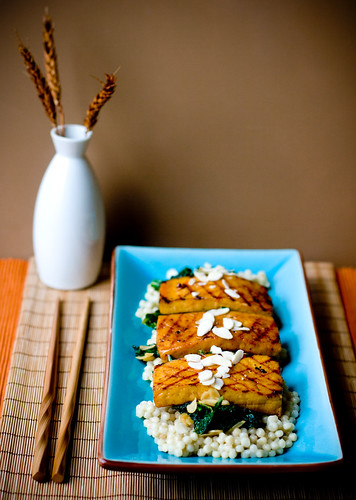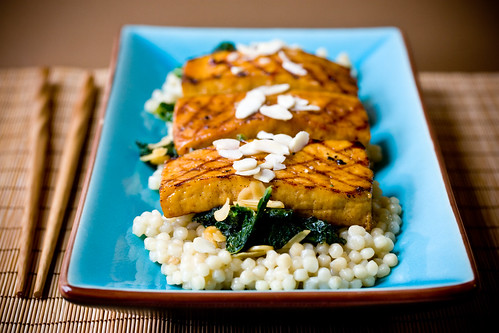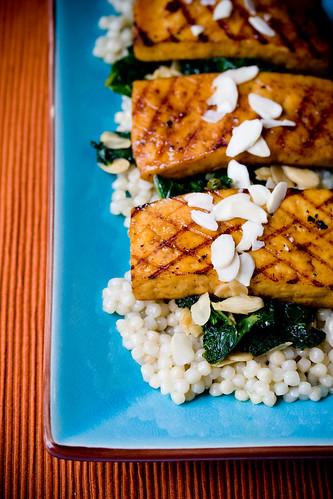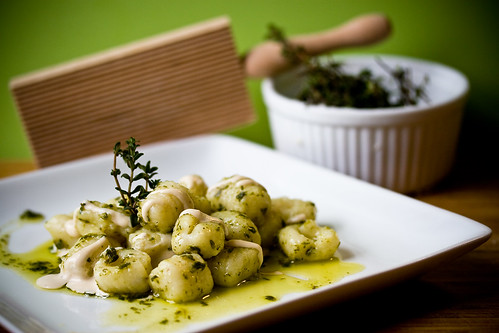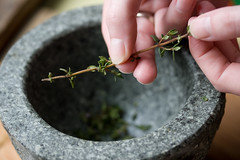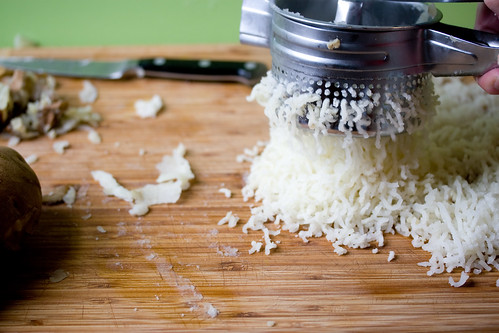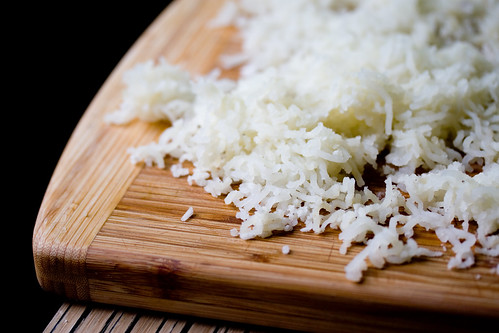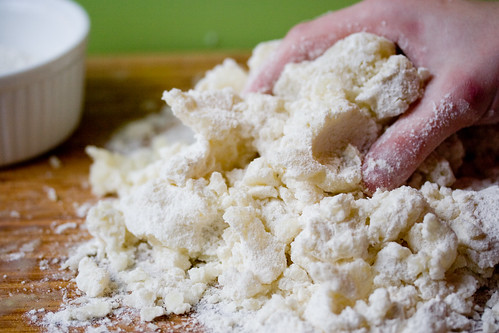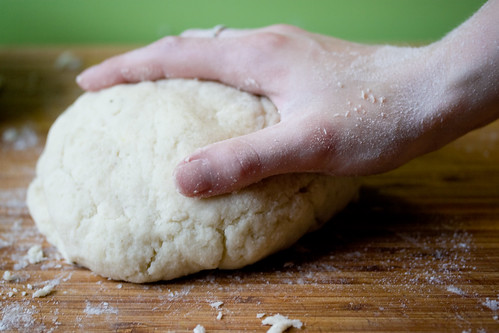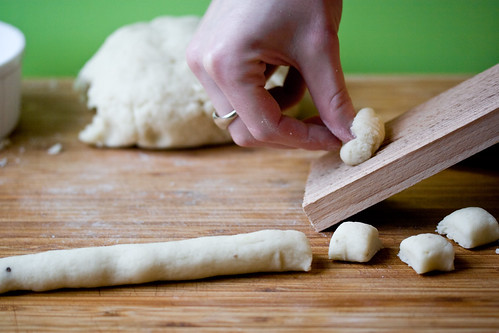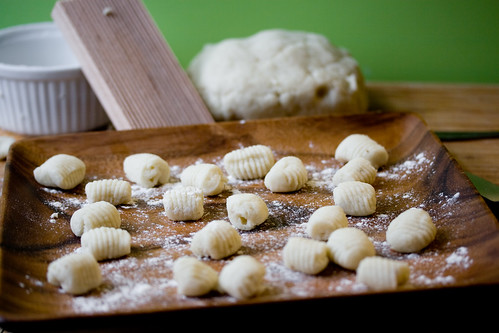Marmalade Tofu with Kale and Lemon Pearl Couscous
Did anyone make the marmalade? This is the perfect recipe to use it in. If you’re not up for making marmalade from scratch, that’s not a problem. Next time you’re at the store pick up a small jar and use that instead. In fact, using store-bought marmalade makes this dish super-duper easy to prepare.
Marmalade chicken is one of those simple dinner dishes that home cooks have been preparing for themselves or their families for years because it’s not only damn easy, but also damn tasty. There are a ton of different recipes available for it online, some just call for marmalade and chicken (or in our case, tofu or seitan), and some make a more elaborate marinade using the marmalade as a base.
This dish is as easy as you want it to be, super flavorful, and infinitely customizable. You can use a base of rice, couscous, pasta, quinoa, millet, polenta (and so on) and dress it up with any simply prepared greens or veggies you’ve got. If your using a rice cooker for your starch, and the oven for the tofu, you can quickly steam or saute up any other accompaniment without much fuss.
I grilled the tofu after I baked it because I love grill marks. The use of a grill or a grill pan is totally optional, unless you’re like me and like really pretty tofu. If you’re free of my strange tofu vanity issues, don’t worry one bit. However, if you do break out the grill pan, be careful not to burn the ‘fu. All the sugar in the marmalade makes for easily scorched tofu if you’re not careful. I may or may not be speaking from experience. *cough cough*
One last thing before I jump into the recipe. Pearl couscous. Oh my goodness, have you tried this stuff? I love it! It’s also called israeli couscous or maftoul. Like regular coucous, it’s actually a pasta, but it’s like couscous on steroids. It’s really fun and a nice change of pace from rice. You should be able to find it near the regular couscous, either in a package near the pastas or in a bin in the bulk food section of your local grocery store. You can boil/drain it like regular pasta, or cook it in a skillet like risotto. Very cool stuff.
Marmalade Tofu with Kale and Lemon Pearl Couscous
Serves two with leftover tofu, easily scaled
1 14 oz block of Super Firm Tofu, pressed well (or 4 seitan cutlets)
1 Recipe Marmalade Marinade, below
Couscous, risotto style
1 Cup Pearl Couscous
2 tsp Oil
2 tsp Fresh Lemon Juice
Zest from 1 Lemon
1/2 tsp Salt (scant)
2 to 2 1/2 Cups Water
Kale
1 bunch Kale (or about 2 cups veg of choice)
2 tsp Oil
2 Tbs Water
1-2 tsp Tamari
1/4 cup Sliced Almonds
Marmalade Marinade
5 Tbs Marmalade
2 Tbs Tamari or Soy Sauce (reduced sodium)
1 Tbs Fresh Lemon Juice
1/2 tsp Hot Chili Flakes (optional)
1/4 tsp Ginger (optional)
Freshly Ground Black Pepper
Preheat oven to 400º F.
My favorite method for pressing tofu: Pour off all excess water. Wrap the tofu in two paper towels. Then wrap the tofu in a terrycloth kitchen towel. Place a cast-iron skillet on top (or anything else that’s flat and heavy and can get wet) and let sit for 20 minutes or longer. After 20 minutes, the towel should be soaked through and the tofu nice and firm. The paper towel just protects the tofu from any lint or, um, cat hair that might be on the towel. Slice the block into 8 even rectangles.
 In a baking dish that will fit all the tofu snuggly, whisk together your marinade. Add the tofu (or seitan) and coat each piece. Bake for 30 minutes, flipping halfway. There should still be a little marinade in the bottom of the dish after baking, just enough to use as a glaze.
In a baking dish that will fit all the tofu snuggly, whisk together your marinade. Add the tofu (or seitan) and coat each piece. Bake for 30 minutes, flipping halfway. There should still be a little marinade in the bottom of the dish after baking, just enough to use as a glaze.
When tofu is halfway done, heat oil in a large skillet an add dry couscous. Stir for a few minutes until each pearl is coated and lightly toasted. Add lemon juice, zest and salt. 2 cups of water and let simmer, stirring frequently, and watch as the couscous absorbs the liquid. When all liquid is absorbed, try a pearl to see if it is cooked through. Add more water as necessary. You can also boil the couscous, drain, then mix in the salt, juice and zest with a little oil.
In the last few minutes, heat the oil for the kale in a wok or large skillet. (The tofu will hold nicely in a warm oven if you need more time.) Add washed, torn kale and toss to coat. Add water to the hot pan and quickly cover with any lid that will fit to quick-steam the kale. Remove the lid after a few minutes (admire how tender and green the kale looks) and saute to cook off any remaining liquid. Add almonds and tamari, stirring well, until the almonds are lightly toasted.
Plate the couscous and then the kale. Add the tofu on top, and drizzle any remaining glaze over everything. Garnish with extra almonds if desired.
